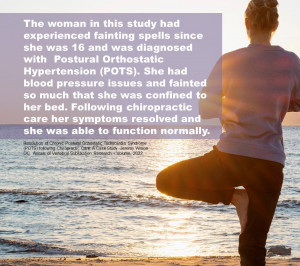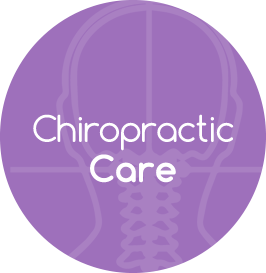Chiropractic Care Helps with Postural Orthostatic Tachycardia Syndrome 
The patient reported on in the study was a 31-year-old female with postural orthostatic tachycardia syndrome, POTS, since she was 16 years of age. She also had neck pain from working long hours. Her neck pain did not interfere with activities of daily living, but she did get tightness in her neck and upper back. She was on medication to balance her salt and water to normalize her blood pressure. She weaned herself off because of the way it made her feel.
The chiropractor examined her and found structural shifts in her neck, midback, low back, and pelvis. She had decreased range of motion, tenderness, and muscle spasms. These structural shifts can lead to obstruction of the nerves and it is this obstruction, called vertebral subluxations, that chiropractors correct.
Following chiropractic care, the frequency and intensity of the POTS decreased, and her neck pain and upper back resolved. She was able to sit and work without pain.
The study’s author called for additional research to investigate the clinical implications of chiropractic care of those with POTS.
Reference: Resolution of Chronic Postural Orthostatic Tachycardia Syndrome (POTS) following Chiropractic Care: A Case Study Jeremy Wilson DC. Annals of Vertebral Subluxation Research ~ Volume, 2022.
POTS – Facts
Postural Orthostatic Tachycardia Syndrome, POTS, is a blood circulation disorder that directly affects blood pressure and heart rate. This is a form of dysautonomia impacting the autonomic nervous system.
It is characterized by experiencing a specific group of symptoms when standing up and an increase in heart rate of at least 30 beats per minute in adults. Symptoms can include lightheaded, brain fog, fatigue, headache, intolerance of exercise, blurry vision, palpitations, tremor, and nausea. It affects one to three million Americans, more commonly affecting women.
It is diagnosed using a 10-minute standing test or a head tilt table test. Management typically involves dietary modifications, exercise, and sometimes medication. The major concern for those with POTS is falling due to fainting from lightheadedness.
The nervous system controls and coordinates all functions of the body and structural shifts in the spine can occur that obstruct the nerves and interfere with their function. These structural shifts can lead to obstruction of the nerves and it is this obstruction, called vertebral subluxations, that chiropractors correct. The upper cervical spine is particularly vulnerable to structural shifts that can potentially injure, impair, compress, or interfere with the brainstem neural pathways.
By removing the structural shifts, chiropractic improves nerve supply and function. The chiropractic adjustment is the means in which the structural shifts are removed. It is a safe, specific force applied to a joint. Chronic problems tend to arise if the vertebral subluxation is left untreated. Chiropractic helps the body heal itself without the use of drugs or surgery.


